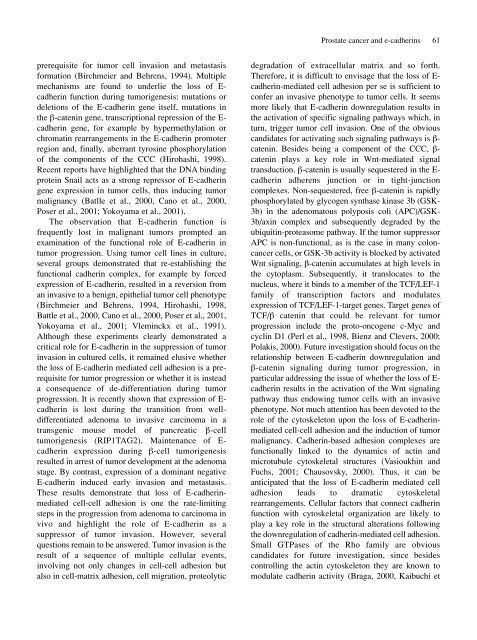(Converted)-5 - Journal of Cell and Molecular Biology - Haliç ...
(Converted)-5 - Journal of Cell and Molecular Biology - Haliç ...
(Converted)-5 - Journal of Cell and Molecular Biology - Haliç ...
You also want an ePaper? Increase the reach of your titles
YUMPU automatically turns print PDFs into web optimized ePapers that Google loves.
prerequisite for tumor cell invasion <strong>and</strong> metastasis<br />
formation (Birchmeier <strong>and</strong> Behrens, 1994). Multiple<br />
mechanisms are found to underlie the loss <strong>of</strong> Ecadherin<br />
function during tumorigenesis: mutations or<br />
deletions <strong>of</strong> the E-cadherin gene itself, mutations in<br />
the β-catenin gene, transcriptional repression <strong>of</strong> the Ecadherin<br />
gene, for example by hypermethylation or<br />
chromatin rearrangements in the E-cadherin promoter<br />
region <strong>and</strong>, finally, aberrant tyrosine phosphorylation<br />
<strong>of</strong> the components <strong>of</strong> the CCC (Hirohashi, 1998).<br />
Recent reports have highlighted that the DNA binding<br />
protein Snail acts as a strong repressor <strong>of</strong> E-cadherin<br />
gene expression in tumor cells, thus inducing tumor<br />
malignancy (Batlle et al., 2000, Cano et al., 2000,<br />
Poser et al., 2001; Yokoyama et al., 2001).<br />
The observation that E-cadherin function is<br />
frequently lost in malignant tumors prompted an<br />
examination <strong>of</strong> the functional role <strong>of</strong> E-cadherin in<br />
tumor progression. Using tumor cell lines in culture,<br />
several groups demonstrated that re-establishing the<br />
functional cadherin complex, for example by forced<br />
expression <strong>of</strong> E-cadherin, resulted in a reversion from<br />
an invasive to a benign, epithelial tumor cell phenotype<br />
(Birchmeier <strong>and</strong> Behrens, 1994, Hirohashi, 1998,<br />
Battle et al., 2000, Cano et al., 2000, Poser et al., 2001,<br />
Yokoyama et al., 2001; Vleminckx et al., 1991).<br />
Although these experiments clearly demonstrated a<br />
critical role for E-cadherin in the suppression <strong>of</strong> tumor<br />
invasion in cultured cells, it remained elusive whether<br />
the loss <strong>of</strong> E-cadherin mediated cell adhesion is a prerequisite<br />
for tumor progression or whether it is instead<br />
a consequence <strong>of</strong> de-differentiation during tumor<br />
progression. It is recently shown that expression <strong>of</strong> Ecadherin<br />
is lost during the transition from welldifferentiated<br />
adenoma to invasive carcinoma in a<br />
transgenic mouse model <strong>of</strong> pancreatic β-cell<br />
tumorigenesis (RIP1TAG2). Maintenance <strong>of</strong> Ecadherin<br />
expression during β-cell tumorigenesis<br />
resulted in arrest <strong>of</strong> tumor development at the adenoma<br />
stage. By contrast, expression <strong>of</strong> a dominant negative<br />
E-cadherin induced early invasion <strong>and</strong> metastasis.<br />
These results demonstrate that loss <strong>of</strong> E-cadherinmediated<br />
cell-cell adhesion is one the rate-limiting<br />
steps in the progression from adenoma to carcinoma in<br />
vivo <strong>and</strong> highlight the role <strong>of</strong> E-cadherin as a<br />
suppressor <strong>of</strong> tumor invasion. However, several<br />
questions remain to be answered. Tumor invasion is the<br />
result <strong>of</strong> a sequence <strong>of</strong> multiple cellular events,<br />
involving not only changes in cell-cell adhesion but<br />
also in cell-matrix adhesion, cell migration, proteolytic<br />
Prostate cancer <strong>and</strong> e-cadherins 61<br />
degradation <strong>of</strong> extracellular matrix <strong>and</strong> so forth.<br />
Therefore, it is difficult to envisage that the loss <strong>of</strong> Ecadherin-mediated<br />
cell adhesion per se is sufficient to<br />
confer an invasive phenotype to tumor cells. It seems<br />
more likely that E-cadherin downregulation results in<br />
the activation <strong>of</strong> specific signaling pathways which, in<br />
turn, trigger tumor cell invasion. One <strong>of</strong> the obvious<br />
c<strong>and</strong>idates for activating such signaling pathways is βcatenin.<br />
Besides being a component <strong>of</strong> the CCC, βcatenin<br />
plays a key role in Wnt-mediated signal<br />
transduction. β-catenin is usually sequestered in the Ecadherin<br />
adherens junction or in tight-junction<br />
complexes. Non-sequestered, free β-catenin is rapidly<br />
phosphorylated by glycogen synthase kinase 3b (GSK-<br />
3b) in the adenomatous polyposis coli (APC)/GSK-<br />
3b/axin complex <strong>and</strong> subsequently degraded by the<br />
ubiquitin-proteasome pathway. If the tumor suppressor<br />
APC is non-functional, as is the case in many coloncancer<br />
cells, or GSK-3b activity is blocked by activated<br />
Wnt signaling, β-catenin accumulates at high levels in<br />
the cytoplasm. Subsequently, it translocates to the<br />
nucleus, where it binds to a member <strong>of</strong> the TCF/LEF-1<br />
family <strong>of</strong> transcription factors <strong>and</strong> modulates<br />
expression <strong>of</strong> TCF/LEF-1-target genes. Target genes <strong>of</strong><br />
TCF/β catenin that could be relevant for tumor<br />
progression include the proto-oncogene c-Myc <strong>and</strong><br />
cyclin D1 (Perl et al., 1998, Bienz <strong>and</strong> Clevers, 2000;<br />
Polakis, 2000). Future investigation should focus on the<br />
relationship between E-cadherin downregulation <strong>and</strong><br />
β-catenin signaling during tumor progression, in<br />
particular addressing the issue <strong>of</strong> whether the loss <strong>of</strong> Ecadherin<br />
results in the activation <strong>of</strong> the Wnt signaling<br />
pathway thus endowing tumor cells with an invasive<br />
phenotype. Not much attention has been devoted to the<br />
role <strong>of</strong> the cytoskeleton upon the loss <strong>of</strong> E-cadherinmediated<br />
cell-cell adhesion <strong>and</strong> the induction <strong>of</strong> tumor<br />
malignancy. Cadherin-based adhesion complexes are<br />
functionally linked to the dynamics <strong>of</strong> actin <strong>and</strong><br />
microtubule cytoskeletal structures (Vasioukhin <strong>and</strong><br />
Fuchs, 2001; Chausovsky, 2000). Thus, it can be<br />
anticipated that the loss <strong>of</strong> E-cadherin mediated cell<br />
adhesion leads to dramatic cytoskeletal<br />
rearrangements. <strong>Cell</strong>ular factors that connect cadherin<br />
function with cytoskeletal organization are likely to<br />
play a key role in the structural alterations following<br />
the downregulation <strong>of</strong> cadherin-mediated cell adhesion.<br />
Small GTPases <strong>of</strong> the Rho family are obvious<br />
c<strong>and</strong>idates for future investigation, since besides<br />
controlling the actin cytoskeleton they are known to<br />
modulate cadherin activity (Braga, 2000, Kaibuchi et

















